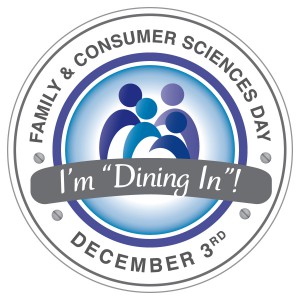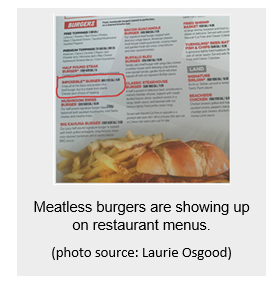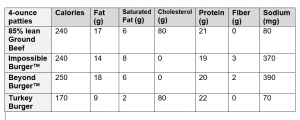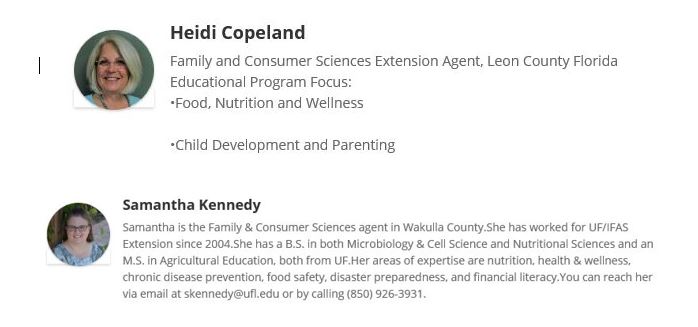
by Laurie Osgood | Nov 25, 2019

Photo credit: UF/IFAS NW District
Rice and pasta are a staple of most family meals. But did you know these simple grains can lead to a foodborne illness? Uncooked rice and pasta can contain spores of Bacillus cereus, a bacterium that can cause foodborne illness. These spores can survive even when rice or pasta is cooked. If the rice or pasta is left standing at room temperature, like in a pot on the stove, these spores can grow into bacteria. These bacteria will then multiply and produce toxins (poisons) that can cause foodborne illness. Bacillus cereus, sometimes called B. cereus, can cause nausea, vomiting, and abdominal cramps.
Preventing Contamination by B. Cereus
Because B. cereus endospores are heat resistant, they are likely to survive cooking at temperatures that would destroy other foodborne pathogens. Bacillus cereus spores can grow when exposed to heat or improper handling.
Recommendations for Proper Handling of Rice and Pasta:
- Cook rice and pasta at 135ºF or above and maintain at that temperature outside of the refrigerator.
Serve rice or pasta as soon as it is cooked.
- Cool in the refrigerator at 41ºF or below within 2 hours of cooking.
- Store rice or pasta in the fridge using a shallow container or resealable bags.
- Cooked rice or pasta can be stored in airtight containers in the fridge for 3 – 5 days.
- Do not reheat rice or pasta more than once.
During the holidays, celebrations usually center around family and good food, and, therefore, our refrigerators easily can become full. We tend to leave rice or pasta out on the stove when there isn’t any room in the fridge. This is where the problem occurs. By following proper food handling techniques, you can ensure that everyone enjoys the holidays and the fabulous foods that are part of the festivities.
To learn more about Bacillus cereus or other foodborne illnesses, contact your UF/IFAS County Extension Office.
Resources:
UF/IFAS Electronic Data Information Source (EDIS), Preventing Foodborne Illness: Bacillus cereus
The Number of Food Poisoning Cases Caused by Bacillus cereus is on the Rise. (2015, April 1). Infection Control Today. Retrieved from https://www.infectioncontroltoday.com/food-safety/number-food-poisoning-cases-caused-bacillus-cereus-rise

by Angela Hinkle | Nov 21, 2019
Make the pledge Tuesday, December 3rd to Dine In for better health – physical, social, and cultural.
Why
Most of us eat every day without thinking about it. We need to eat to nourish our body, so it’s just a regular thing we do. But eating also can be an important social and cultural way for families to come together.

FCS Dine In Day
When we eat together as a family, it gives us the opportunity to practice cultural traditions and share food histories. We get the chance to explore new foods and learn new skills – like eating with chopsticks. We may get the chance to learn and practice table manners and learn literary and conversation skills. Paul Fieldhouse of the Vanier Institute of the Family says, “For young children, ‘table talk’ may be the main source of exposure to family conversation and the expression of thoughts, ideas, and emotions.” Eating the family meal also can help us de-stress by setting a reassuring rhythm and structure to our day.
Eating family meals at home has additional benefits. The University of Washington found that families who cook and eat more often at home tend to eat a healthier diet. Their Healthy Eating Index is high – meaning they eat more fruits and vegetables and less calories, sugar, and fat. They eat smaller portions helping to regulate weight. Some research suggests we eat smaller portions at home because we eat more slowly and talk more. This, however, does not equate to a higher cost. Meals cooked at home generally cost less than those eaten out.
How
So, how can your family eat more meals together at home?
- Try making and eating meals at home a priority for your family. Think about how important it is spending time together.
- Keep it simple. Don’t worry about making a big, fancy meal.
- Start with just a few meals a week. Then slowly add more meals together as you find your “family meal groove.”
- Let the whole family help plan meals. Think about foods your family likes and build around those ideas. Try to get all the MyPlate healthy food groups in – whole grains, plenty of fruits and vegetables of all colors, shapes, and textures, lean plant and animal proteins, and low- and no-fat dairy. Make your grocery list together.
- Let everyone be involved in planning, preparing, table setting, and cleaning up afterwards.
- Make it a goal to start this December 3rd to Dine In for better health.
Resources:
(Still) Eating Together: The Culture of the Family Meal. Retrieved November 16, 2019 from https://vanierinstitute.ca/eating-culture-family-meal/
Cooking at Home Tonight? It’s Likely Cheaper and Healthier. Retrieved November 15, 2019 from https://www.sciencedaily.com/releases/2017/03/170314150926.htm

by Kendra Hughson | Oct 21, 2019

Most foods freeze well. Pancakes are easy to make ahead and freeze for later use. Photo Credit: Kendra Zamojski
You get home after a busy day and now it’s time to figure out what to make for dinner. You open the pantry and the refrigerator in a search for something to make for dinner. Maybe you can’t find the right ingredients or you don’t feel like cooking, so you pick up the phone to order delivery. A little planning ahead, could help you save money and make healthier choices.
Meals that you can make ahead and freeze are great to have on hand for use on busy days. According to the USDA, most foods can be frozen. Canned foods and shell eggs should not be frozen. This is because liquid expands when frozen and can cause shelled eggs and metal cans or glass jars to crack or break. Instead, remove canned foods from metal cans before freezing. To freeze eggs, beat together yolk and whites for better quality; egg whites can be frozen separately. Some foods don’t freeze well like mayonnaise, cream sauces, and lettuce. These exceptions aside, make ahead meals are easy to freeze and convenient to have on hand.
Cooking ahead doesn’t need to be complicated. Start freezing leftovers for later use or try doubling recipes when you are already cooking. Soups, stews, chili, casseroles, sloppy joes, and taco filling are easy recipes to experiment with batch cooking. Freeze in airtight plastic or glass containers or freezer safe bags or packaging. If you freeze foods in glass or plastic containers, leave 1-2 inches of head space between the food and the lid to allow room for expansion. Use labels to identify the frozen products, including the date and any cooking instructions. Store food in the quantities that you want to use for later. For example, whole casseroles can be reheated for family meals or soups and stews can be stored in single-serving quantities for quick and easy lunches. Freeze quickly for the best quality and to reduce freezer burn.
When it’s time to thaw, plan ahead. Do not thaw foods on the counter. Cook frozen foods immediately after thawing. Use one of the following recommended methods:
- Refrigerator: Small quantities can thaw in the refrigerator overnight. Larger quantities may take a day or two.
- Water method: Place in a sealed, leak-proof plastic bag and submerge in cold water. Change the water every 30 minutes, until thawed.
- Microwave defrosting: Defrosting in the microwave can cause some parts of the food to start cooking. Be sure to cook foods immediately after thawing.
- Cooking from a frozen state: Casseroles and other prepared foods can be cooked from a frozen state. Plan for extra cooking time by adding 15 to 30 minutes to the cooking time. Use a food thermometer to be sure it reaches an internal temperature of 165 degrees. Never place a frozen dish in a hot, pre-heated oven.This could cause the dish to crack or break.
If you enjoy experimenting with batch cooking, there are a lot of great resources for make ahead recipes and weekly meal plans. For more information, contact your local UF/IFAS Extension office: http://sfyl.ifas.ufl.edu/find-your-local-office/
Sources:
Freezing and Food Safety: https://www.fsis.usda.gov/wps/wcm/connect/cce745c9-0fc9-4ce6-a50c-84363e5b5a48/Freezing_and_Food_Safety.pdf?MOD=AJPERES
Make Ahead Freezer Meals to the Rescue: https://extension.psu.edu/make-ahead-freezer-meals-to-the-rescue
Freezing Food for Multiple Meals: https://www.ksre.k-state.edu/humannutrition/nutrition-topics/eatingwell-budget/makeaheadmeals.html

by Laurie Osgood | Oct 11, 2019
Meatless Burger Alternatives

If you have been watching television lately, you may have seen commercials for meatless burgers that are making a splash. Many restaurants including Burger King and Red Robin are now offering this alternative meat source on their menus. https://www.bk.com/menu-item/impossible-whopper, https://www.redrobin.com/burgers/impossible-burger.html,
Beyond Beef™ and Impossible Burgers™ are two of the meat alternatives created by The Beyond Meat ™ https://www.beyondmeat.com/products/ and The Impossible Foods https://impossiblefoods.com/ companies. The Beyond Burger™ and Impossible Burger™ are similar in ingredients, color and texture, and they actually taste like…meat!
According to Emily Gelsomin, in the August 19th edition of Harvard Health Publishing, “Plant-based burgers are not a novel concept. But new products designed to taste like meat are now being marketed to vegetarians and meat-eaters alike”. Gelsomin suggests that meatless burgers are a good source of protein, vitamins, and minerals.
But What Are They?
Keep in mind that meatless burgers are created in a lab, not in a pasture. Meatless burgers look, sizzle, and even “bleed” like a regular hamburger. But they contain no animal protein and are a completely plant-based patty. This plant-based protein is a blend of potato and soy proteins. Meatless burger alternatives get their red color and “bleeding” effect from beet juice. Meatless burgers sizzle while being cooked because of sunflower and coconut oils, the meatless burger’s fat sources. To hold everything together, meatless burgers contain methylcellulose, a bulk-forming fiber source.
Are Meatless Burgers Safe?
Yes, meatless burgers are safe to eat, unless you are allergic to soy, coconut or sunflower.
The Good News:
Meatless burgers contain less sodium, cholesterol and fat than traditional beef or ground turkey patties do. Meatless burgers contain 2-3 grams of fiber per serving, whereas traditional hamburger patties contain no fiber.
The Bad News:
Just because they are a plant-based alternative to meat, doesn’t mean that they are healthier for you. The calories found in a meatless burger are similar to a traditional beef patty and meatless burgers are heavily processed and high in saturated fat.
How Do These Meatless Burger Alternatives Compare Nutritionally to Ground Beef and Ground Turkey Patties?

Source: Harvard Health Blog. Impossible and Beyond: How healthy are these meatless burgers? August 15, 2019.
The Bottom Line:
Meatless burgers such as The Impossible Burger™ and Beyond Burger™ are unique alternatives, although nutritionally not that different from a traditional hamburger patty. However, due to its popularity, companies such as Impossible Foods and Beyond Meat have struggled to keep up with the demand.
Contact your local Family & Consumer Sciences Extension Agent to learn more about meatless alternatives.
Sources
https://www.health.harvard.edu/blog/impossible-and-beyond-how-healthy-are-these-meatless-burgers-2019081517448
Shopping for Health, Vegetarian Diets https://edis.ifas.ufl.edu/pdffiles/FS/FS16700.pdf

by Ginny Hinton | Jun 4, 2019
America’s favorite superfood is ripe in the Florida Panhandle! Well, it may not actually be everyone’s favorite, but it’s definitely a tasty superfood. Of course, I’m talking about the blueberry. If you love the sweet nutritious little blue fruit, now is the time to pick or purchase fresh from a local source.

Blueberries: Spectacular, Summer, Superfood
Photo source: Ginny Hinton
When it comes to antioxidants, blueberries are king. Antioxidants help protect our bodies from oxidative stress, which is linked to many diseases including arthritis, heart disease, stroke, and high blood pressure. They also help strengthen our immune system. Blueberries have one of the highest antioxidant levels of all common fruits and vegetables.
Blueberries are high in fiber (about 4 grams per serving), vitamin C and vitamin K. Of course, they’re also low in calories. Blueberries are available fresh in the Panhandle from late May into June.
When you’re picking blueberries, look for ones that are firm, dry, plump and smooth-skinned with a light greyish bloom. Stick to the deep blue ones for the sweetest flavor. Cover them and they’ll stay fresh in the refrigerator for up to ten days, or they can be easily frozen. Put them in a single layer on a baking sheet or cookie tray and freeze, then store them in airtight, resealable plastic bags. That way, they won’t stick together and you can use just the amount you need. Once you thaw them out, just be sure to use them within three days. Store blueberries unwashed and don’t rinse them until you’re ready to use them.
Don’t love to eat them plain? Nutritious, delicious blueberries are great in lots of dishes. For a quick breakfast or snack, add them to yogurt or cottage cheese and enjoy! Use them to flavor pancakes, waffles or muffins. Add them to a green salad for a sweet flavor burst. However you eat them, know that you’re doing a good thing for both your health and your taste buds.
Enjoy blueberries!

by Samantha Kennedy | Apr 10, 2019

One way to be more sustainable when shopping for groceries is to use reusable shopping bags. They’re durable and sturdy and can help reduce the number of plastic bags that end up in the landfill each year. (Photo source: Samantha Kennedy)
Sustainability should not just be a buzzword during Earth Month. The fact that everybody either shops for or eats groceries means the whole grocery shopping experience is a good time to reflect and improve upon what we can personally do to embrace issues of sustainability.
This year in April, the Earth Month theme focuses on Returning to Nature. There is no better place to start a quest for personal sustainable improvement than the grocery store! Grocery shopping truly embraces the three main areas of sustainability: environmental, economic, and social. In fact, it has been well documented that the average family wastes about 25% of the food it purchases. (Much of this ends up in a landfill and creates problems of its own.)
With a bit of forethought, meal planning before grocery shopping can help individuals and families apply sustainable best practices for environmental, economic, and social well-being. In fact, many of the principles of sustainability can be effectively applied to both meal planning and grocery shopping.
RESPECT yourself. Good nutrition is one of the keys to a healthy life. Improve health by keeping a balanced diet. Vow to make healthier food choices for personal health and the environment.
REFUSE to use food products that do not fit your principles of sustainability. This may mean buying food with less packaging, eating more locally-grown fruits and vegetables, or looking for foods labeled as more responsibly sourced.
REDUCE the amount of food thrown out. Planning meals ahead of time and writing out a grocery list are excellent ways to start living sustainably. Planning not only saves money on groceries, it can save time and decrease the amount of personal food waste a family contributes. (Remember, freezing products can prolong their life, so if you find that you’ve overbought, try preserving some of your bounty for later use.) Reducing the number of trips to the grocery store also can help save on fuel and transportation costs.
REUSE /REPURPOSE food for another occasion. Careful meal planning helps ensure that leftovers from one meal can be incorporated into the next one, thereby reducing food waste.
RETHINK! Healthy, nutritious, delicious, and inexpensive grocery choices can be found in every food group. Not all food has to be prepackaged. In fact, with a bit of planning, dinner can be on the table in 15 minutes. (That’s less time than it takes to wait in line at a fast food restaurant.)
BE RESPONSIBLE! Use what you buy.
Stock up on low-cost healthy grain products like whole-wheat noodles, brown rice, and store-brand cereals and oatmeal.
Purchase fruits and vegetables that are in season and cost less. In addition, do not forget that frozen, dried, and canned fruits and vegetables can play an important part in meal planning.
Buy the largest size you can effectively use before it reaches the expiration date – and look for the items with the latest dates. Purchase store brands or generic brands whenever possible. Keep in mind smaller containers tend to cost more, no matter what the food group. Buying larger packages and dividing them into smaller portions can save money and reduce the amount of packaging that ends up in the landfill. Investing in small, reusable storage containers will save money and reduce waste in the end.
Practice Meatless Monday. The protein group provides inexpensive protein sources like beans, lentils, and eggs, which can be substituted for meat in many meals.
Protein does not have to be the most expensive item purchased. Consulting the store’s weekly sales flyer during meal planning can help you plan meals around meat and poultry items that are on sale.
Prepare food your family will actually eat. There are two schools of thought here: preparing just enough for one meal or preparing big-batch recipes that provide leftovers which can be frozen for later use. Either practice can be sustainable. Freeze leftovers only if you’re going to use them. Otherwise, cut down on the amount of food cooked to help reduce food waste.
Learn how to cook. Prepare and eat more meals at home. It is sustainable, good for you, and delicious. Meals cooked at home are more nutritious, less expensive, and result in less overall waste, such as packaging.
Two additional ways to be more sustainable when grocery shopping are to use reusable shopping bags and to stop using single-use plastic produce bags. Plastic grocery bags choke our landfills and end up in our water bodies. They are not biodegradable and can last thousands of years virtually intact. Reusable shopping bags are made from recycled materials and can drastically reduce the number of plastic bags that end up in the trash each year.
For more information on making your grocery shopping more sustainable, check out these related articles:
Freezing: Nature’s Pause Button (UF/IFAS Extension)
What’s in your FREEZER? (UF/IFAS Extension)
Best Practices for Shoppers at the Farmers’ Market (UF/IFAS Extension)
Sustainable Grocery Shopping (University of Northern Iowa)

UF/IFAS Family and Consumer Sciences Agents Heidi Copeland and Samantha Kennedy















